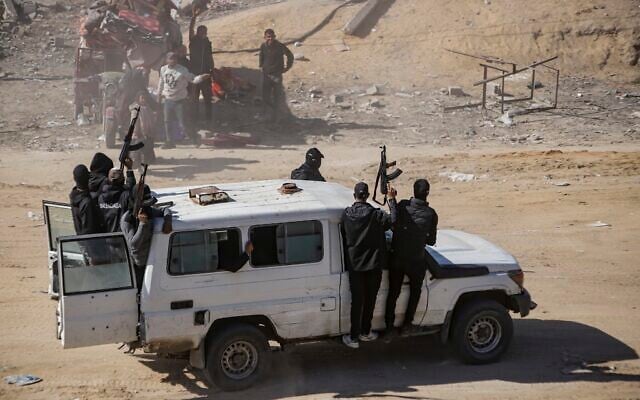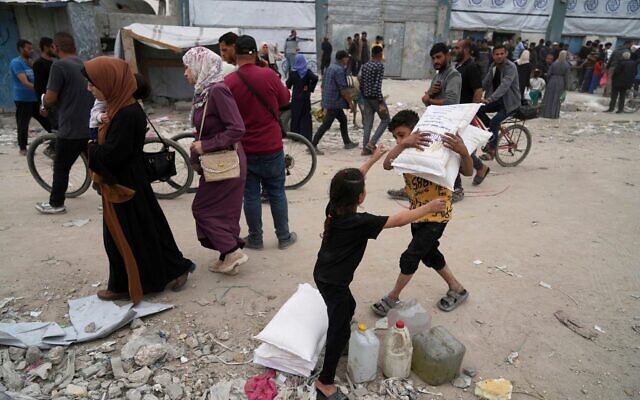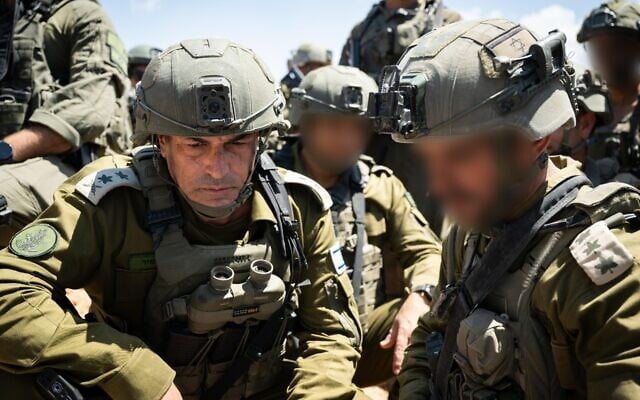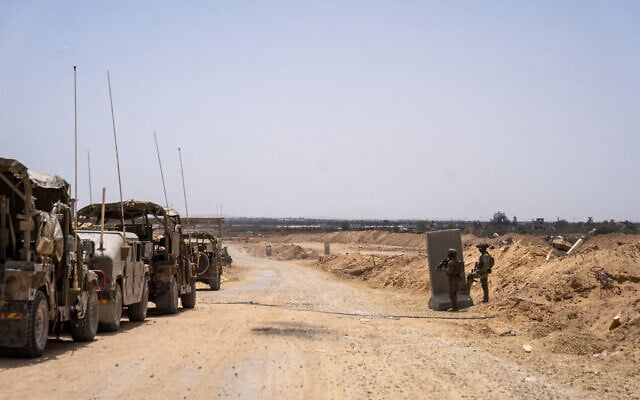


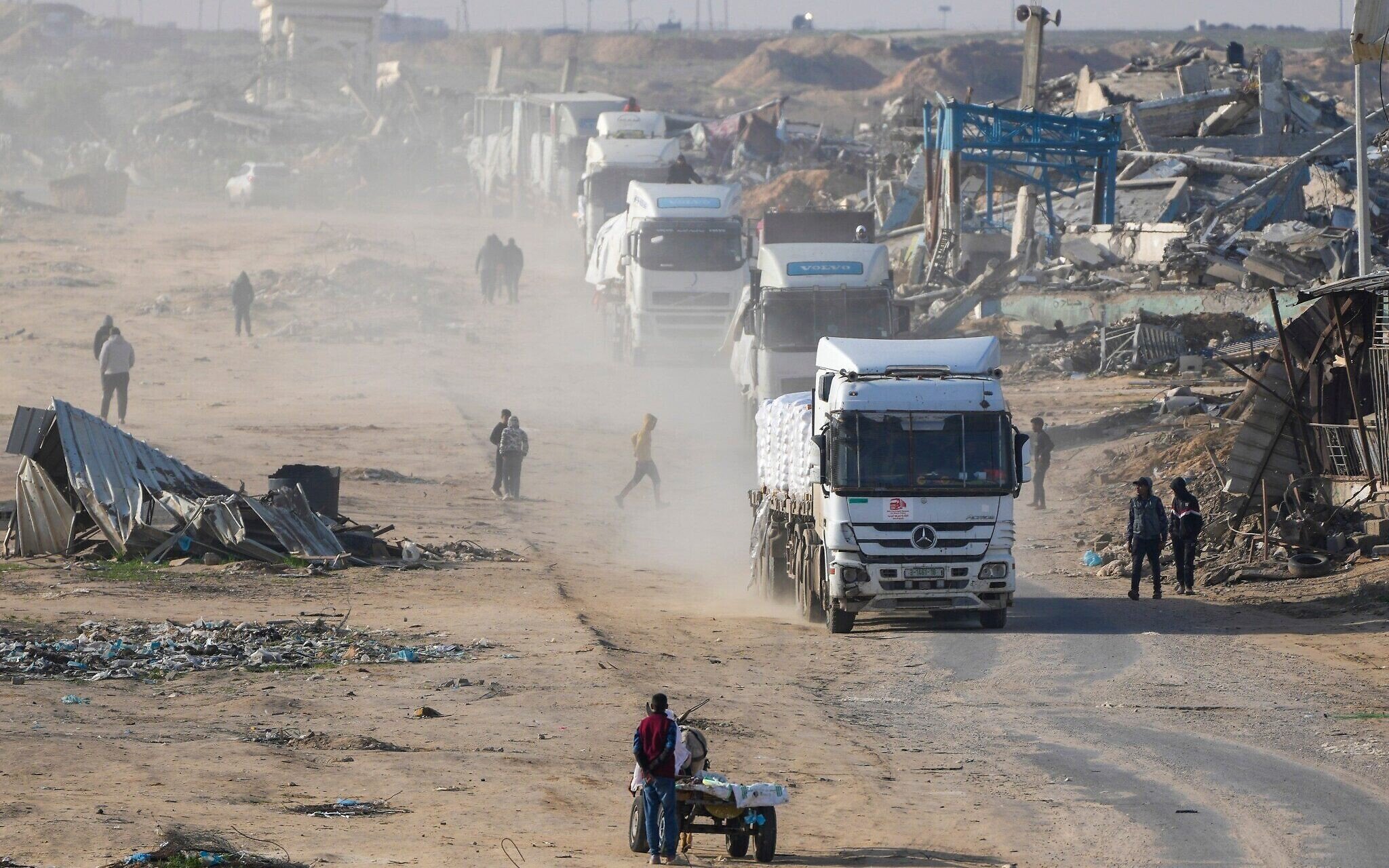
Israel is planning to radically alter the way humanitarian aid is distributed in the Gaza Strip when it begins allowing assistance into the enclave in the coming weeks after what will have been a nearly two-and-a-half-month freeze, an Israeli and Arab official familiar with the matter told The Times of Israel this week.
The plan is to transition away from wholesale distribution and warehousing of aid and to instead have international organizations and private security contractors hand out boxes of food to individual Gazan families, according to the officials.
Each family will have a designated representative tasked with reaching an Israel Defense Forces security zone in southern Gaza where aid will be distributed after going through several rounds of inspection. Each box will have enough food to last a number of days until family representatives will be allowed to return to the security zone to receive another parcel, the officials said, adding that Israel believes this method will make it harder for Hamas to divert aid to its fighters.
The IDF will not be directly involved in the distribution of aid, amid pushback from Chief of Staff Lt. Gen. Eyal Zamir; but troops will be tasked with providing an outer layer of security for the private contractors and international organizations handing out the assistance, the officials said.
One of the main companies slated for involvement in the plan is an offshoot of an American national security consulting firm called Orbis, whose executives have ties to Strategic Affairs Minister Ron Dermer, the Israeli official said. The company could not be reached for comment.
There is no exact timeline for when the new system will come into place, but the IDF believes that it only has several weeks before a major humanitarian crisis, the Israeli official said.
Israel stopped allowing aid into Gaza on March 2 after the first phase of a ceasefire and hostage release deal concluded. Jerusalem argued that Hamas diverted much of the aid that entered during the 6-week-long truce, but that the 650 trucks per day were enough to feed the population for an extended period.
Israel has engaged in negotiations aimed at a ceasefire extension during which it is willing to allow the resumption of aid into the Strip in exchange for the release of hostages, but those talks have yet to reach a breakthrough.
The new plan for aid distribution plan has not received final approval from the government, but does have the backing of much of the security establishment along with key figures in Prime Minister Benjamin Netanyahu’s inner circle, the Israeli official said.
The Arab official briefed on the plan was skeptical of its ability to successfully box out Hamas from the aid distribution process, noting that representatives tasked with picking up boxes of food for their families will face a dangerous and potentially long trek from their tents in the humanitarian zone.
“They’ll be like sitting ducks,” the Arab official warned.
He added that the plan appeared to also limit the amount of food each family will receive to the bare minimum needed for survival. “It’s like they’re counting calories of a population that has already been starved for months.”
The Arab official further expressed skepticism that the plan could be replicated at scale for Gaza’s entire population, even as it continues to be squeezed into smaller and smaller areas within the decimated Strip.
“This seems to be part of the slow crawl toward a permanent Israeli occupation of Gaza where the IDF will end up being the ones directly responsible for aid distribution,” the Arab official said.
The Arab official argued that a better alternative for aid distribution would be to employ operatives linked to the Palestinian Authority — an idea Israel has rejected as the PA has linked its cooperation on Jerusalem establishing a political horizon for Ramallah.
The Arab official said that granting a foothold to the PA would also unlock additional support from Arab countries that have expressed willingness to play a role in the post-war management of Gaza in a manner that isolates Hamas.
The IDF in recent days has recommended that the Israeli government approve the resumption of humanitarian aid deliveries to the Gaza Strip, regardless of a hostage deal with the Hamas terror group, in a bid to avoid starvation among the Palestinian civilian population, according to military officials who briefed reporters earlier this week.
The IDF has made it clear to the political echelon that resuming the entry of aid will soon be necessary to avoid violations of international law and future legal problems for commanders who are taking part in the military operation.
“The IDF recommendation is to create aid distribution areas, using international organizations and companies, while securing them during the distribution and preventing the aid from reaching Hamas,” a military official said during the briefing.
Still, the Israeli military official said that it would “act in accordance with the guidance of the political echelon regarding the distribution of aid.”
The halt of aid deliveries to Gaza was part of Israeli efforts to pressure Hamas back into a hostage deal. At the same time, the IDF resumed its offensive in Gaza, seizing large sections of the Strip’s territory and killing an estimated 400 members of terror groups, including dozens of top officials in Hamas’s politburo and military wing.
The military official acknowledged that “despite the military pressure being exerted, the Hamas terror organization remains unwilling [to agree to a deal].”
Therefore, the military official said the IDF was preparing to call up a large number of reserve troops in the coming period to “significantly” expand the offensive in Gaza by operating in new areas of the Strip.
The military said that calling up reservists was being carried out solely out of “matter-of-fact and operational interests,” amid mounting letters signed by veterans calling for a hostage deal with Hamas, even if it comes at the cost of ending the war.
The military official said that the IDF’s main missions remain returning the 59 hostages still held by Hamas in Gaza, roughly two dozen of whom are presumed alive, and collapsing the terror group’s rule over the Strip.
Over 2,300 Palestinians have been killed in Gaza since Israel resumed hostilities there on March 18, out of more than 52,400 killed since the war there was sparked by the Hamas onslaught of October 7, 2023, according to the Hamas-controlled health ministry.
The figures cannot be independently verified, and do not distinguish between combatants and civilians. Israel says it has killed some 20,000 combatants in battle as of January, and another 1,600 terrorists inside Israel during the Hamas onslaught.
The Hamas-led attack saw thousands of terrorists storm southern Israel to kill some 1,200 people and take 251 hostages. Fifty-nine hostages remain in Gaza, including the body of a soldier killed fighting in the 2014 war there.
Israel’s toll in the ground offensive against Hamas in Gaza and in military operations along the border with the Strip stands at 414. The toll includes two police officers and two Defense Ministry civilian contractors.

